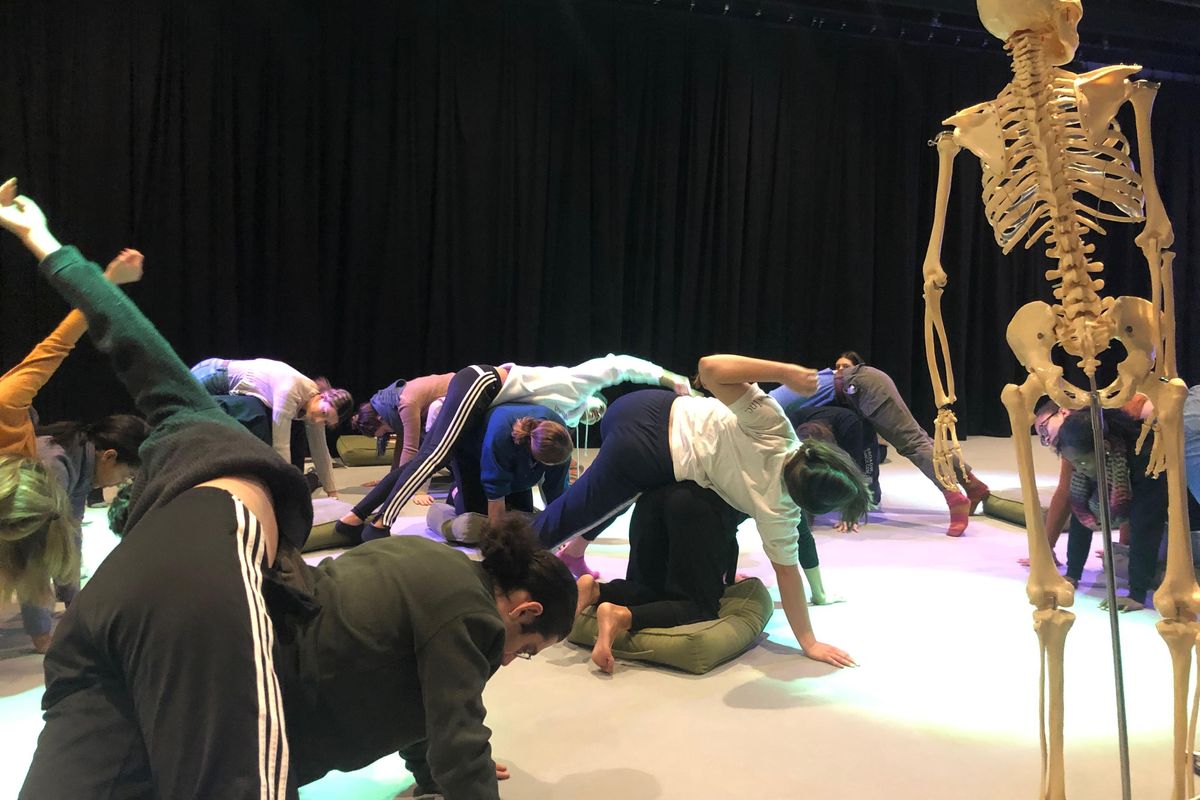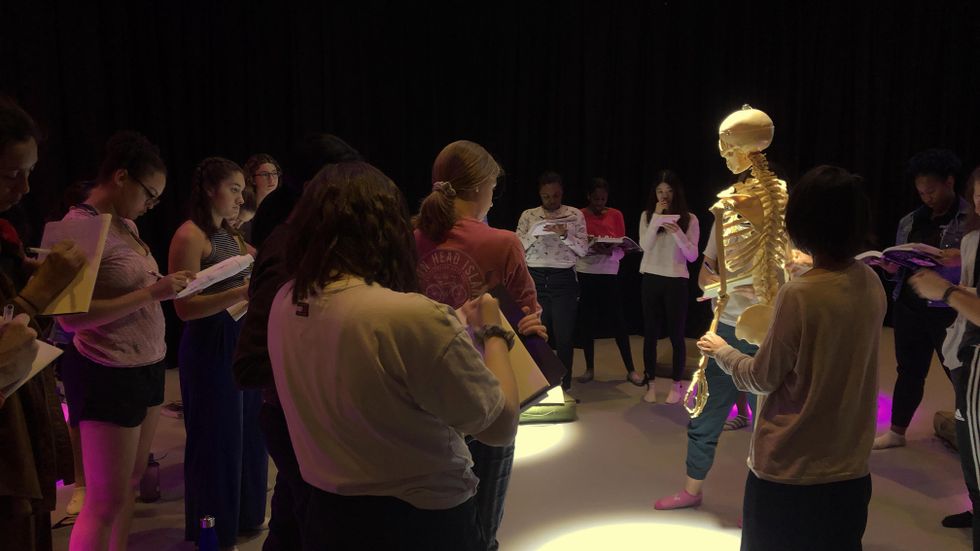
Gail Accardi believes there should be a model skeleton in every dance studio.
“How the body works can be mysterious, especially to beginners,” says the New York City–based teacher, who has taught anatomy awareness courses at Peridance Capezio Center and Dance New Amsterdam. “A visual aid can help students understand what the body is actually doing in various dance movements.”
But using a skeleton to demonstrate a port de bras or développé is only one way to get students familiar with how their body parts team up to perform choreography. Dance Teacher spoke to three educators about how to foster an understanding of anatomy in dancers of all ages.
Why Teach Anatomy, Anyway?
“If dancers know how their body works, they can care for it more responsibly,” says Terry Goetz, director of the Creative Dance Center (CDC) in Seattle, Washington. “They can also be empowered to advocate for themselves.” That may mean being able to speak up when a movement doesn’t feel safe. It could also mean having the language to explain to a doctor or physical therapist exactly what hurts, and when it hurts.
But there are benefits beyond health and safety. “Your body is your instrument, and if you understand its components, you can play it more expressively,” says Chisa Hidaka, who teaches Applied Anatomy of Human Movement at Barnard College in New York City. “Then, when you dance, you aren’t just mimicking shapes. You’re using your specific instrument to do something precise and nuanced.”
While many college dance majors include an anatomy course, you can begin to incorporate this knowledge much earlier. At CDC, building body awareness starts in infant/caregiver class. “I’ll have the parent pat the baby’s arm and say ‘This is your arm,’ so the baby feels and hears and sees,” says Goetz. “That sensory experience builds connections in the brain.”

Use Correct Terminology
Knowing your scapula from your patella isn’t just for people in the medical field. Though complex anatomical terminology may feel like a barrier, Hidaka says dancers are ideal learners because they already spend so much time paying attention to what their bodies can and can’t do. “This knowledge is so relevant to a dancer’s life,” she says, “which makes it very accessible.”
Goetz says even young children can pick up anatomical terms. “The idea that there are simple words and longer, more interesting words to describe our body parts is fascinating to kids,” Goetz says. As you teach, use anatomical terms like “lumbar spine” interchangeably with descriptive terms like “lower back.” The more often young dancers hear those words in context, the more likely it is they’ll stick. (If you need a refresher yourself, Hidaka recommends dance teachers read The Body Moveable, by David Gorman.)
Early exposure will help college students more easily memorize terminology for quizzes and exams. But memorization and regurgitation are not the end goals. That’s why Hidaka also gives writing assignments where students must think about what they’re learning in relationship with their own movement practice. “They need to see how the scientific information applies to their dancing,” Hidaka says. “Knowing what a thing is called is important—but not as important as having a sense of what it is and how it works.”
Get a Clear Visual
“Dancers take in a lot of information visually,” Accardi says. But there is often a gap between seeing something and being able to reproduce it. Think of a preschooler struggling to stand in first position: She can see that her toes should point away from each other, but she doesn’t understand that she must rotate her leg from the hip to make it happen. “Using a three-dimensional, moveable skeleton, you can say ‘This is how your leg moves in the hip socket,'” Accardi says. “‘This is how your knee joint is built and how it’s meant to bend.'”
Posters that show muscles, tendons and ligaments can deepen understanding. Hidaka also recommends the app Essential Anatomy 5, which allows users to zoom in on and view body parts from various angles, as well as video tutorials by The Noted Anatomist and AnatomyZone on YouTube. If you work with young children who might be afraid of a skeleton or a detailed diagram, you could turn to other models to demonstrate body mechanics; for instance, a door hinge could help students visualize the hinge joints at the knees and elbows.
The goal with each tool is to show how the human body is designed—and what that design means for dancers. If you have props and posters on hand in the studio, take five minutes out of class or rehearsal to explain how a movement breaks down anatomically. Then, students can get to work putting the knowledge into their bodies.
Make It Multisensory
Engaging multiple senses helps students retain information. That’s why, aside from the skeleton, one of the most tried-and-true tools in an anatomy teacher’s tool kit is a coloring book. (There are several on the market; Hidaka prefers Netter’s Anatomy Coloring Book, 2nd Edition.) “Dancers are multimodal learners,” Hidaka explains. “Coloring gives you a motor activity to do as you read a word and think about what it means.”
Having students be hands-on with their own bodies is another tactic. During the BrainDance—a body and brain warm-up movement sequence developed by CDC founder Anne Green Gilbert—teachers often ask young students to palpate and name body parts: “Squeeze your shin. That bone is called your tibia.” Have young students experiment with the possibilities in their muscles and joints. “How does your shoulder move? How can you bend your knee? How about your wrist?” Goetz asks. “Children love to explore their bodies.”
In her anatomy awareness class, Accardi often demonstrates a concept on the skeleton and then has dancers try it for themselves. A lesson on turnout could involve students lying on their backs and internally and externally rotating their legs, with knees extended and bent. When everyone is focused on basic movement mechanics, you have an opportunity to discuss anatomical variations. For instance, “Each student’s turnout will depend on how deep or shallow the hip socket is, where the socket is positioned on the pelvis, and on the shape of the femur bone,” Accardi says. “The person next to you may have more or less rotation. You can learn to work with your unique anatomy.”

Put It All Together
Introducing anatomical concepts in technique class has the potential to create dancers who have greater control over and respect for their instrument. “Everyone wants to learn about themselves,” Goetz says. “Teaching anatomy is a wonderful way to feed children’s natural curiosity. And for dancers, the more we understand how body parts function in isolation, the more we can end up with this beautiful, articulate integration.”




